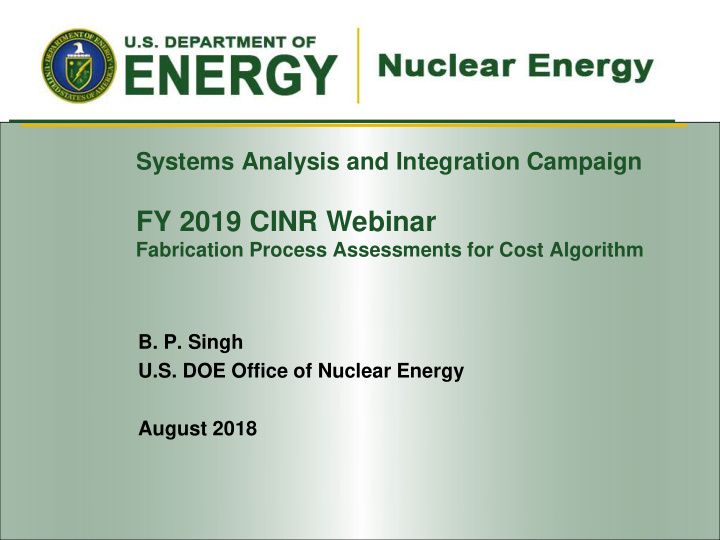



Systems Analysis and Integration Campaign FY 2019 CINR Webinar Fabrication Process Assessments for Cost Algorithm B. P. Singh U.S. DOE Office of Nuclear Energy August 2018
SA&I Campaign Objectives Perform top-notch analysis of nuclear energy systems to determine technical and economic viability, identifying benefits and challenges Utilize and enhance leading-edge systems analysis tools, models and processes & capabilities Campaign Focus Area of Call: Development of algorithms for estimating the cost of nuclear energy facilities and sub-systems in a bottom-up evaluation approach – Supports improving the cost basis of fuel cycle facilities that have a substantial impact on the economic performance of nuclear energy systems – Enables estimating capital costs of advanced nuclear reactors and fuel cycle facilities, including for systems that have not been built August 2018 FY 2019 CINR Webinar 2
Background Information The Systems Analysis and Integration (SA&I) Campaign is developing algorithms for estimating the capital cost of systems and subsystems in a Nuclear Energy System (NES), e.g., advanced reactor designs, fuel fabrication facilities, fuel processing facilities, etc. – Facilitates independent assessments of claims about capital costs for advanced concepts – Standardizes approach for capital cost estimation – Fills an identified gap in the tools available to DOE – Offers insights on the cost drivers for advanced designs – Informs R&D decision making about cost reduction for advanced concepts August 2018 FY 2019 CINR Webinar 3
Recent Activities The SA&I Campaign started working on this topic in FY 2017 – Total costs of complete large mechanical nuclear components, e.g. RPVs, etc., were derived from older sources, as a function of size and material Work done in FY 2018 incorporated some knowledge from the forging industry – Helped confirm the cost ranges and the relative costs of initial fabrication steps for large nuclear components, as a function of material and fabrication complexity August 2018 FY 2019 CINR Webinar 4
Expectations for the FY 2019 Call Provide models, algorithms and descriptions of fabrication complexity, and ultimately of the cost of fabrication of large mechanical components, whether N- stamped or not – Engage industrial partners (e.g., forging companies, fabricators, nuclear vendors, architect engineers etc.) – Starting from the fabrication steps and complexity, develop cost models that can be implemented in the SA&I cost algorithms for advanced NES All the fabrication steps should be included in the analysis – Melting of ingot with proper chemistry and condition control, forging, extrusion, plate bending, welding, machining, quality control, inspections, paperwork, and delivery to customers, etc. For the various fabrication steps, the cost models developed should consider various materials typically used in nuclear constructions (e.g., carbon and stainless steel, advanced alloys) and nuclear versus non-nuclear standards Identify the major cost drivers Close interaction with the campaign national laboratory personnel August 2018 FY 2019 CINR Webinar 5
Recommend
More recommend